





(Editor's Note: This article was originally published on August 31, 2008. Your comments are welcome, but please be aware that authors of previously published articles may not be able to respond to your questions.)
This article is more about general watering strategies, but with palms as the main example. There are many ways to water plants and palms are not terribly unique in their water requirements so what is discussed below could be applicable to many other kinds of plants, particularly of tropical or warm weather plants in arid regions (where rain cannot be relied upon to help). However there are a few special considerations when trying to keep your palms healthy and happy and watered at the same time.
Unlike many trees or shrubs the same size, palms have relatively wimpy simple and shallow roots. Compared to many of the other plants I grow (cycads, cacti and succulents), however, palms actually have relatively large and aggressive root systems and will usually out compete the root systems of these other plants if planted in the same pot/planter or small section of garden. This works out well for the palms in my garden, and can even work out well for the succulents as the palm roots will suck up most of the water keeping the nearby succulents from sitting in too-moist-a-soils. But for cycads, this is not always a good thing as they often dehydrate then. But that is another article.
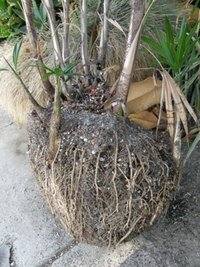 All palm roots are basically the same size and shape and don't grow too deep
All palm roots are basically the same size and shape and don't grow too deep
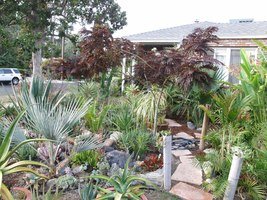
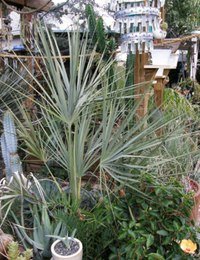
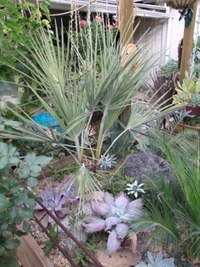
Watering palms in these gardens (shots of my yard) involve special considerations as one needs to water these roots well, but without overwatering the surrounding succulents and cycads
But compared to most other similar sized plants, palms have small and weak roots. If you plant a palm under an elm, for example (something I have done repeatedly) your palm may suffer as elms have a much more extensive and aggressive root systems and keeping your palm roots happy can require nearly constant watering. Thankfully palms don't need a lot of room for their roots, so completely taking over and crowding out a palm's roots is not so easy. But know your plants roots and that will help you to design some appropriate watering strategies.
For the most part, palms are very tolerant of watering extremes. Of course there are hundreds of exceptions, but most commonly grown palms can handle both excesses of water as well as periods of drought fairly well. This sadly leads to much abuse of palms in public landscaping with many public plantings being grossly under-watered simply because the palms can tolerate it... but they don't like it and may not thrive or look good. This commonly adopted public watering strategy is one of the reasons many people don't like Queen palms or Trachycarpus since under-watered trees usually survive, but rarely look good. This in turn gives these palms a bad name.
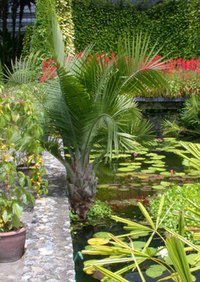 Here's one extreme- this Majesty palm is planted IN the water yet it's happy as can be
Here's one extreme- this Majesty palm is planted IN the water yet it's happy as can be
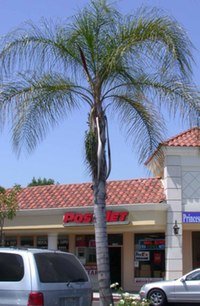
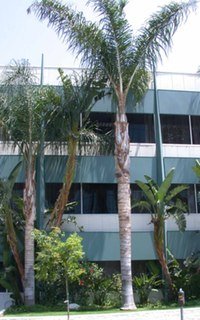
Both Queen palms are somewhat healthy but the wispy sad one on the left gets just enough water to keep alive, while the robust monsters in the right photo get watered every time the lawn does and show their appreciation!
A common house palm, Chamaedorea elegans (Parlor Palm) is a rainforest species that grows where there is ample water most of the year. However, this species is surprising and impressively drought tolerant, surviving and even managing to look half way decent despite prolonged periods of neglect (one of the reasons they make such good house plants) particularly in low light situations where little photosynthesis is going on. But this palm is almost impossible to overwater as well.
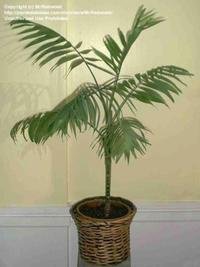 Chamaedorea elegans does amazing well if hardly watered... or excessively watered. (photo by MrRedwood)
Chamaedorea elegans does amazing well if hardly watered... or excessively watered. (photo by MrRedwood)
In the words of Pauleen Sullivan, one of the most experienced and wisest palm growers I know, it is impossible to overwater a palm. As I mentioned, there are exceptions to this rule (particularly if a palm is planted in poorly draining soil) but for the most part it's true. Dypsis decaryi (Triangle Palm) is one of these exceptions and overwatering this palm can result in its demise. In general, however, the more the average palm is watered, the faster it grows. If one lives in a climate where water is cheap and plentiful this can allow one to obtain a large, mature palm garden in a short amount of time.
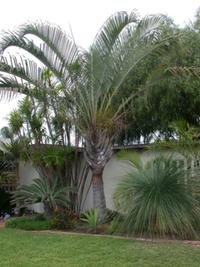 A good choice for this drought tolerant garden, Dypsis decaryi will sometimes die if overwatered in a dry climate... for some reason this is not a big concern if grown in a tropical climate
A good choice for this drought tolerant garden, Dypsis decaryi will sometimes die if overwatered in a dry climate... for some reason this is not a big concern if grown in a tropical climate
The good thing about palms is they also grow well on amazingly little amounts of water. This is particularly good to know if one does NOT live in a climate where water is cheap and plentiful (such as here in Southern California, where we basically live in a desert and all out water is ‘borrowed' from northern California or rapidly depleting aquifers). And it is in this type of climate where one learns (one hopes to learn) how to water palms efficiently and effectively.
The hose: Despite my 15 years of growing palms and a schedule that requires me to spend most of my waking hours working, or driving to and from work, this is still my preferred method of watering. This is NOT the most efficient or effective way to water, though... so do as I say, not as I do. Dragging about a hose and watering everything that way has its advantages and disadvantages. The main advantage to me is it gives me time and an excuse to stare at my palms. Inspection of one's palms allows one to catch problems before they get too serious (this is true only if one THINKS as well as stares), like insect infestation, dehydration, rot, pruning needs etc. And I like to look at the plants. After all, the reason I like these plants is that I enjoy looking at them. There is really no other reason I grow them, other than perhaps hoping to learn something about them I can pass on to others... but really, it's the selfish pleasure of just getting to look at them. Other ‘remote' watering strategies do not afford one nearly so much ‘staring' time.
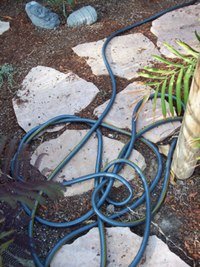
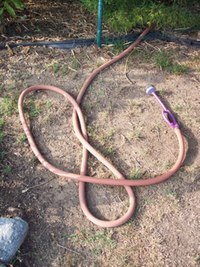
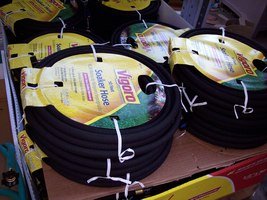
Two shots of my own hoses... not too attractive and always underfoot... but really HANDS ON! Last shot shows a soaker hose, a great way to deeply soak the soil, but pretty inefficient use of water in that it waters anything in its path.
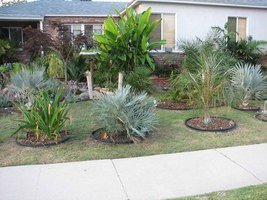 With a hose I can easily water JUST the palms leaving that useless grass stuff to get its own water
With a hose I can easily water JUST the palms leaving that useless grass stuff to get its own water
Another advantage of watering with a hose is I can spray each palm's foliage in an individualized fashion. Pauleen Sullivan also said that palms like to have their faces washed... in other words, they appreciate their foliage wetted frequently (most palms live naturally where rainfall far exceeds what we get here and appreciate any humidity they can get). There are some limits to ‘face washing', though, and this is particularly important to know if one waters palms with a hose, or especially with a broadcast sprinkler system (see discussion below). Some palms do NOT like to have their crowns repeatedly soaked with tap water, particularly during the cooler times of day or year. One of the most common reasons for bud rot (the bud is the growing center of the palm where the new leaves come from) in palms is excessive watering of the crowns. Palms that are exceptionally predisposed to this problem include most of the pinnate-leaved palms that do not have crownshafts. Why these palms as a group are particularly sensitive to this crown watering is unknown to me... and the ‘fact' of this is not really a ‘fact', but more of a personal observation. Some fan palms are also predisposed to this bud rot from overwatering their crowns, particularly the blue fan palms (blue Braheas, Chamaerops ‘cerifera', some blue Livistonas etc.). This is a lesson I have ‘learned' over and over and over again (obviously I am a slow learner) and my hopes are that you will pay particular attention to this warning so you do not have to learn from your mistakes as often as I have had to. Curiously these palms do not appear to be the least affected adversely by rainwater. There is obviously something about tap water (chemicals, lack of oxygen, lack of acidity, etc.) that is hard on these palm's crowns.
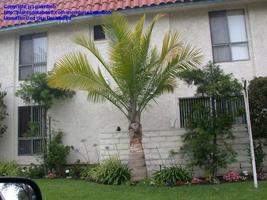
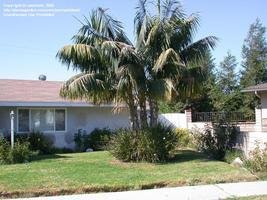
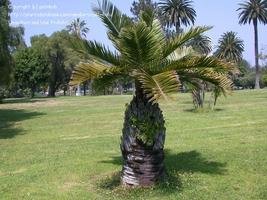
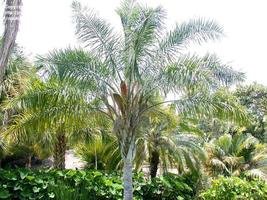

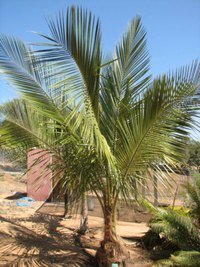
All the above species are typical non-crownshafted pinnate palms that one must be careful NOT to water their crowns excessively (Butias, Howeas, Jubaeas, Syagrus, Majesties and Parajubaeas just to name a few)
Lastly, watering by hose is relatively cheap and simple... only cost requirement is a hose (or several hoses) and water. And turning off/on the water is definitely at my level of technical expertise. There is no digging and little planning ahead required (planning ahead being one of my biggest personal failings).
Hose watering has many disadvantages, most which will be obvious to the reader. One is it is incredibly labor intensive. Watering palms ‘remotely' takes little time and allows one to have a life, basically. Watering a garden any larger than my postage-stamp-sized yard would probably take so much time that it would hardly be worth the effort.
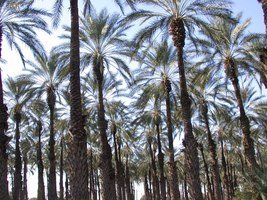
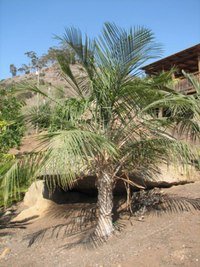
Here are two obvious examples where hose watering wouldn't work- no way to water all those date palms by hand (thank goodness they don't need much water); palms grown on slopes in dry soil are notoriously hard to water efficiently without digging large bowls, or the water will just erode away the slope and never get to the deepest roots.
Another obvious disadvantage is dragging a hose about is hard on the environment (I cannot begin to recall all the times I have knocked over something or uprooted a plant with a hose, no matter how many hose guides I use or how careful I have been).
But most importantly, hose watering is somewhat inefficient. It does allow one to direct water at the desired location (something a large sprinkler does not allow), but high volume hose watering only waters palms well if the soils is able to absorb large quantities of water quickly (this requires lots of mulch, usually). Rarely does high volume hose watering efficiently bring a lot of water to the roots and thoroughly get them wet. Low volume hose watering can, but this entails dragging the hose from location to location to location and letting it soak the ground for many minutes at a time, something that would only work if that is all one ever had to do in life, or if one had a really small garden (even my dinky garden is too large for this sort of hose watering).
Sprinkler systems: large sprinklers, such as rain birds or other broadcast type of sprinklers are an efficient way of watering large areas of land and do not require one to stand there while the watering is going on, and are relatively inexpensive and simple to set up. But this watering strategy is rife with disadvantages as well. This strategy of watering tends to water all the land, not just the palms (so a lot of water goes wasted). It also potentially damages palms and other delicate plants by either physically injuring them with water streams or allowing bud damage to occur (see previous paragraphs).
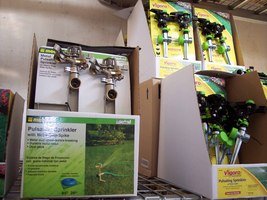
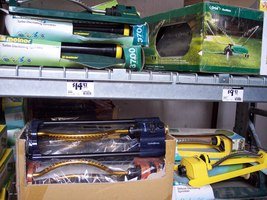
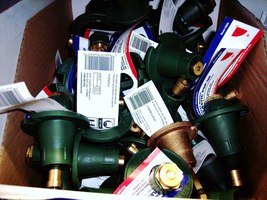
3 different forms of broadcast sprinklers... the first ones are effective for very large gardens or palms grown in lawns, and the last are for average sized gardens (not too many use the kind in the middle any more)
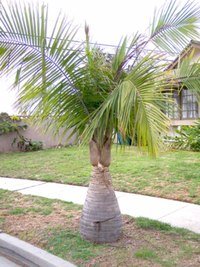
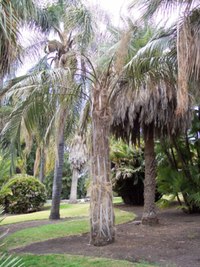
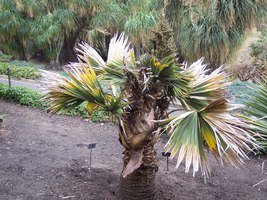
the Majesty, Parajubaea and Sabal above are all suffering from crown rot, something either caused by watering their crowns or made worse by continuing to water their crowns- a definite disadvantage of large broadcast sprinklers
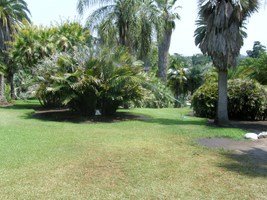
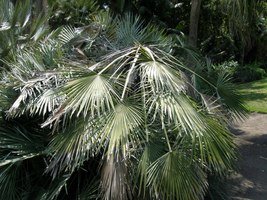
Broadcast watering with large sprinklers in botanical gardens- note all the crowns are getting soaked; Chamaerops with bud rot (and gonna die) that was watered by this very sprinkler
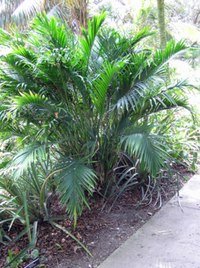
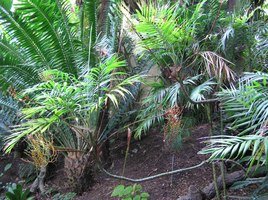
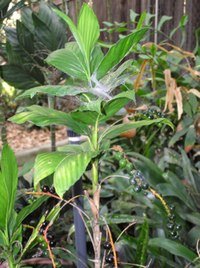
Two different gardens with Chamaedoreas (cataractarum, elegans and tenella) all watered by larger broadcast sprinklers. This genus is perfect for broadcast sprinklers as they benefit from having their foliage watered frequently and very resistant from crown rot.
Small automated sprinkler systems are much more effective and efficient watering systems and are probably the most commonly used watering strategies adopted by most serious palm growers in southern California. These miniature sprinklers provide small amounts of water only at the sites needing water so no water is wasted. Also they tend to water the palms at the soil level leaving the crowns free of water accumulation. Timers allow growers to water different sections of the garden thoroughly every 3-7 days (here in California) depending on weather conditions but using only a fraction of the water one might need using larger sprinkler systems or even with the hose technique. Deep watering every 3-7 days is a lot more effective and efficient than shallow watering daily. This strategy requires no time in the garden dragging about watering equipment... and, if one is really trying hard to grow their palms as healthy as possible, they may even consider adding a water-based fertilizer injector system that puts in a premetered dose of fertilizer along with every single watering. This method is one of the best methods to promote large, healthy root systems in palms (and perhaps other plants as well?) and produces maximum growth potential. But fertilizing palms is another article.
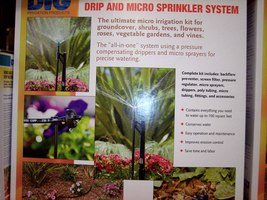
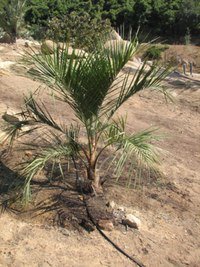
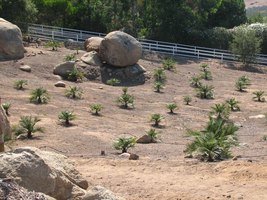
Shot of a miniature sprinkler for sale Two shots of a larger, excellently managed southern California garden on automated minisprinklers- this grower has above ground hoses with connectors at the palms for the sprinklers... maybe not the most attractive set up but it works great and is pretty simple once it's all set up
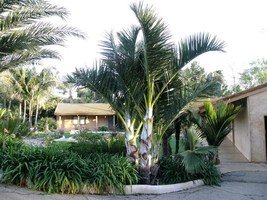
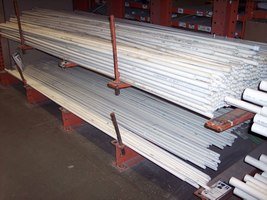
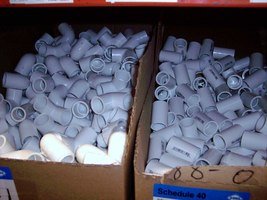
This garden was even more well planned with undeground pvc pipe all throughout it (literally several miles of pipe)... I have done this and it's a TON of work... and when a pipe breaks its fun trying to find it
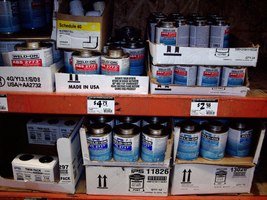
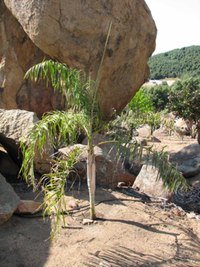
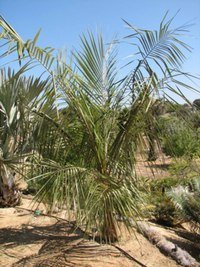
Oh and I did I mention you have to use tons of glue with PVC? It's a mess... sort of fun, though. I think these two gardeners above had a better idea just running the hose along the ground (Dypsis ambositrae and Parajubaea torrallyi being watered by mini sprinklers)
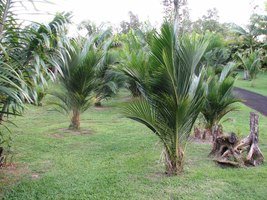
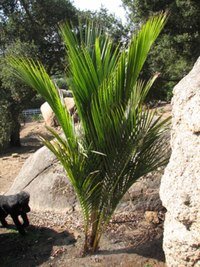
Beccariophoenix 'no window' grown in Hawaii with the benefit of rains, and one grown in southern California with miniature sprinklers... the surrounding scenery may not be the same, but the palm in southern California is growing nearly as perfectly as the ones in Hawaii.
On the down side, this watering strategy costs a fortune to set up, is a tremendous amount of work (tons of digging and putting together sometimes literally miles of PVC pipe) to set up, requires planning ahead (though I have managed in the previous garden to put in such a system AFTER the palms were all planted, but it was even harder then) and, if using timers, requires one to have the knowledge and ability to be both a plumber and electrician (just a tad beyond my average capability on a good day)... of course you can pay someone else to do it all, but that makes it even more costly. And of course it doesn't force you to go outside and look at the progress of the palms and have an excuse to stare at them for a while. Lastly, smaller sprinklers can be damaged easily and if one is not out there observing frequently a palm can quickly die from lack of water in the summer if one does not notice a sprinkler has gone out for some reason (rabbits, gardeners, dogs, children, weeds etc all mess with this sort of system).
Drip: I list this one separately from automated mini-sprinklers only because this strategy has a few advantages and disadvantages despite it's really being about the same in terms of set up, cost and planning. Drip systems are by far the most efficient way to water palms there are. Thanks to a palm having all of its roots basically in one place, all but the larger palms can be watered efficiently with one or maybe two drips on it. It would be hard to water most large trees in this fashion as most tree roots spread for dozens of feet in all directions. Palms whose roots spread some distance are usually mature and the kind that are so drought tolerant they need little additional watering other than what can be provided at the bases of their trunks anyway (perhaps this is true with dicot trees as well?). Drip systems are simply unbeatable when it comes to water savings.
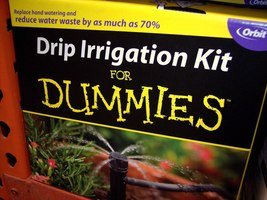
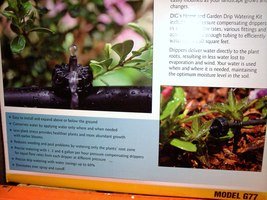
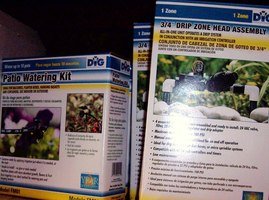
I have tried drip- that is how my last garden was watered. I needed this book though.
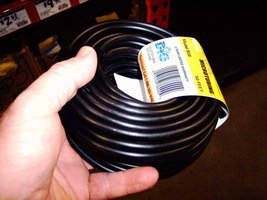
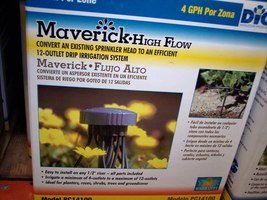
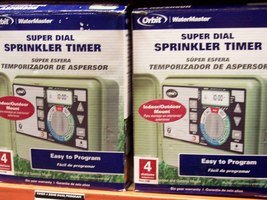
I probably went through about 25 rolls of tubing this size and about the same number of these drip irrigation systems (never did get the timers hooked up)... and then I spent the rest of my life repairing and finding problems.. eventually I went back to using a hose
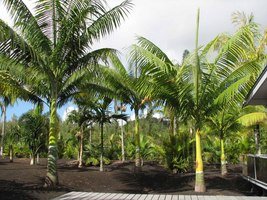
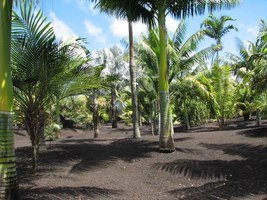
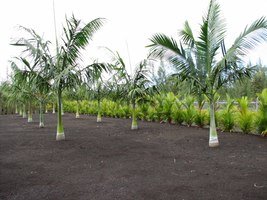
Believe it or not this beautiful garden in Hawaii (8 acres!) is completely equipped with automated drip... though the owner is using drip as a back up to when rain is not available (which it is most of the time fortunately)
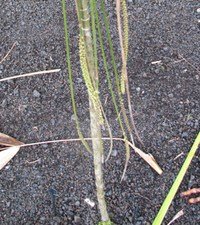
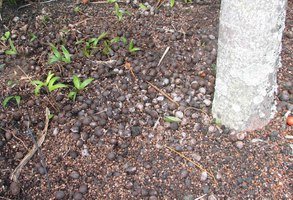 shots of palm bases with drips coming out of the ground
shots of palm bases with drips coming out of the ground
But drips have some huge downsides, the main one that they simply, in practice, don't work well... at least not in most garden settings (better in a confined space like a small patio planter or greenhouse). In a larger garden there is no way to closely monitor which drips stop dripping and this happens all the time for a variety of reasons. The main one is they just tend to plug up with poor quality municipal water. They also are readily consumed by rabbits and other annoying small creatures. Why rabbits find drips so tasty is not really known... perhaps they are just trying to get at the water, too? If one employs gardeners you should know these folks can be nearly as destructive as rabbits in terms of knocking drip systems off their mark, stepping on them or accidentally cutting them in half etc. Drips also do not thoroughly rinse the salts out of the soils the way a good sprinkling can. Most water has salts in it (except that magical elixir known as rain water) that not only cause unsightly white build up on leaves, but can build up to toxic levels in the soils and cause severe root damage. One would still need to thoroughly sprinkler/soak the palms to rinse the soils out regularly (if one lives in a climate like Florida where it rains year round, this may not be a big deal, though). I am not a big fan of drip systems for palm gardens.
Misting Systems: this is not really a true watering strategy, but one that can leave one's palms looking and being healthier in the long run. Misting systems increase the local humidity which allows many tropical plants to survive arid conditions for which many are poorly adapted. This is mostly a luxury in my book (not written yet) but if one has the time, effort and money, it is a great way of keeping many tropical palms looking great even in the hot, drying summer heat/sun.
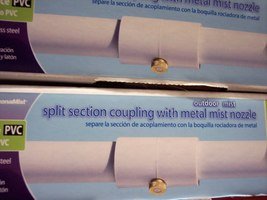
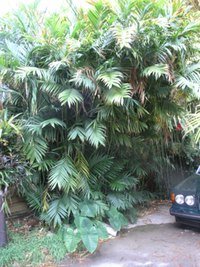
The photo on the right is from a garden in which the owner mists a lot of his palms... The Chamaedorea costaricana is lush and happy in our desert of southern California
Misting systems have to be used judiciously as they can cause the same crown rot problem that excessive hosing and broadcast sprinklers can, so be sure not to mist palms in cold weather, or palms that are predisposed to crown rot (see above). These systems are even more apt to clog than are drip systems thanks to all the gunk that is in most tap waters, and can really be annoying to keep on top of. I have used misting systems in my old greenhouse and I cannot even guess how many times I had to replace or ‘de-lime' the misting heads. I eventually gave up and went back to using a hose.
Rain: last, but not least, is natural watering. This is not something one can rely on where I live as it often does not rain from April until October, which means most palms would be without water during the hottest and arid times of the year (low humidity of around 10% is not unusual here)- most our palms would be dead were we to rely on rainfall. But if you have it, use it. Save it in barrels if you have to. Keep it in a water catchment system. Rain water is pure magic when it comes to watering tropicals or even succulents. Rotting a succulent or a palm's crown with tap water is a no-brainer, but very difficult to do with rain water. Rain water does not have the minerals in it that cause ugly white build-ups on the leaves. Rainwater is acidic which is what 90% of all palms love. And rain water is free. Hard to beat that.

scene outside of Bangkok, Thailand showing rice fields and Borassus palms being watered with 'natural water'
Watering potted palms is a completely different story. I prefer still to use a hose, but I don't have a problem using a drip on these palms- a lot easier to monitor problems and occasional rinse-outs to wash out salts is simple. If one has lots of money and has a lot of potted palms in a greenhouse, it might be worth it to put in a reverse osmosis system. This has several advantages in removing the unwanted salts in the tap water... then one can water overhead with less likelihood of rotting palm crowns (which is already lessened by the constant warmth in a greenhouse) and this water doesn't leave white salt residues on the leaves. But perhaps greenhouse palm care should be a different article.
When to water palms: this may seem like a no-brainer... and it really is. Water when it's hot and dry, and not so much when it's wet and cold. But if it's dry and cold should one water? Yes, but much more care needs to be taken not to water the foliage as much or crown rot will become a serious possibility. But by far the most important time to water palms here in Southern California is when it's windy. Nothing sucks the moisture out of the leaves more efficiently than a good, arid Santa Ana wind. This is especially true after a long cold spell when the palm is likely to be a bit on the dehydrated side anyway as most don't water their palms as much in the winter... but then a warm spell comes along and the drying Santa Anas are like a knife in the back of a humid-needy palm. I have lost healthy looking palms in just a few hours during a particularly arid, warm Santa Ana during the cooler months of the year. Perhaps in many of these situations there would be little I could do even had I been watering all day long... but it sure helps to try.
What palms need lots of water and which need little: this is not something can be covered with any degree of thoroughness in such an article, so I will leave this for another article. But one should know that there are very drought tolerant palms and many that are not that drought tolerant. As I mentioned above, few palms can be overwatered, so if you don't know which your palms are, it is safest to water frequently and thoroughly. It also helps to know your soil well as palms grown in clay can often be watered far less often without worrying about dehydration than for those grown in sand. I had a palm garden in clay and I could get away sometimes without watering for weeks as long as the palms were thoroughly watered originally. One soon learns, too, that some palms just don't like growing in clay, and some love it.
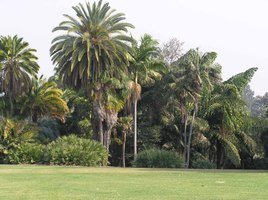

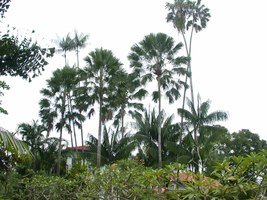
Palm garden in California that is watered with large sprinklers; Hawaii garden on drip and rain; Singapore palms totally dependent on rain (sadly we can't all live in Singapore)
Copyright © www.100flowers.win Botanic Garden All Rights Reserved